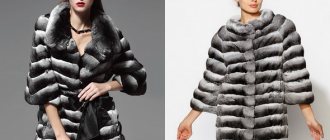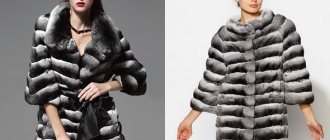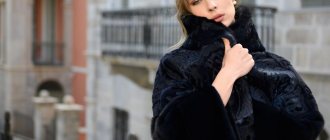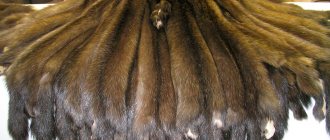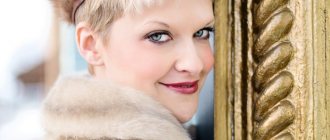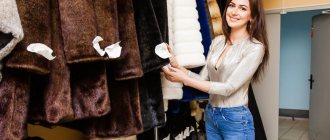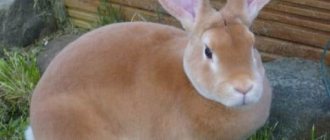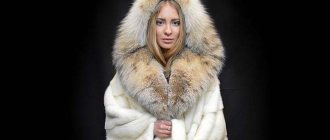All women dream of a new fur coat - this stereotype has long been formed in the minds of most men, and I must say, not without reason. Of course, not every woman dreams of a new fur cape: for some, it is generally unacceptable to wear parts of killed animals; others prefer sheepskin coats. But most still want to buy a new beautiful fur coat.
Varieties of models and colors
Chinchilla fur coats come in a wide range of popular shades. From dark gray to brown or even golden. Recently, bright colors have become very popular, which are also applied to chinchilla fur, because they lend themselves well to dyeing. The most popular color is “Black Velvet”.
Chinchilla can be short-tailed (shore) and long-tailed. The latter is valued more, as it has softer and fluffier fur, and it is also of higher quality and wear-resistant.
To evaluate the quality of a chinchilla fur coat, try pressing your finger on the fur; if a mark remains, then the fur is not of very high quality. In good varieties this mark will be invisible.
The most popular models among chinchilla fur products are short fur coats, vests, and boleros. Long full-length chinchilla fur coats are rarely sewn, because not every master will take on such delicate, painstaking, voluminous work. That is why a floor-length chinchilla fur coat is very expensive and often becomes an absolute exclusive.
This is interesting: White spots under the eyes
What does the price depend on?
The price of a chinchilla in a pet store, nursery and other places where the size of the cost does not depend solely on personal opinion (as with private sellers in markets and advertisements) is determined by the following factors:
- breed;
- the color and color of the coat (animals with a rare or artificially bred color without defects are more expensive);
- quality of fur (density (the thicker, the more expensive), length, etc.);
- features of appearance and physical parameters (correct physique, weight, etc.);
- presence of pedigree;
- age (young animals are always cheaper, since the final color of the animal is established no earlier than 8-9 months of age);
- gender (females are more expensive, since half as many of them are born as males).
When setting the price for a chinchilla, many breeders take into account the purpose of purchasing the animal - to be slaughtered for fur or to be kept as a pet. Thus, a live chinchilla for one purpose and another will differ in cost.
In addition, the asking price for a rodent is related to the place of purchase - the more elite the nursery, the more expensive the animals will be.
Determining the quality of fur
Only animals with high-quality and mature fur are selected for slaughter. Determining the quality of fur is not difficult: the outer hair should be five to six millimeters longer than the down. High-quality fur is thick, without noticeable bald spots or bald spots. All hairs are of even length.
The quality of the fur does not depend on the color, but depends on its evenness and distribution. Chinchilla fur is most valued if on the tummy the stripe of color transition from light to dark is thin, with clear boundaries. The brightness and saturation of the color, its expression and even shine are also important.
An important point in determining the quality of fur is mature skin. You can identify it by color. To do this, you can blow on the fur or gently push it apart with your fingers: immature skin has a bluish, grayish or bluish tint. You will recognize ready and ripe skin by its light pink color, but if the shade of the rodent’s skin is red, the skin is overripe and will be more difficult to work with.
The fur of a rodent of the highest quality is distinguished by its thickness and density, uniformity of color.
If chinchilla skins have abrasions, the skin differs in color from light pink, the color has too bright zonations or is poorly expressed, the fur is faded or has bald patches - they are classified as second class. Such skins usually lose up to 40% in price.
Features and Benefits
Chinchilla fur is very soft and pleasant to the touch, and its texture is quite dense and fluffy. It is this combination that is valued by fur producers, as well as consumers of fur products. In a chinchilla fur coat you don’t feel cold or heavy, because despite the visual volume, such products have a fairly light weight and excellent warming properties.
This feature is explained by the high density of fur and the complete absence of hard hairs on their surface. The main advantage of chinchilla fur products is that they do not smell at all, which is due to the absence of sweat and sebaceous glands in the animal.
Dressing chinchilla skins
Dressing chinchilla skins begins with removal, and here it is important that no fat, blood or water gets on the fur. Otherwise, the workpiece will be damaged. The removed skin is cleaned with the blunt side of a knife from remaining fatty tissue, blood clots, and films. Then it is laid out on a flat and clean surface and the tail and paws are aligned. After the skin is cleaned and smoothed, it is stretched on a frame to dry.
Typically, the drying process takes no more than two days at a room temperature of no more than +15 degrees. If processing is not planned immediately, then the skin can be placed in the refrigerator, where it will be stored for several months without loss of quality and integrity.
The processing process begins by preparing a mixture of nine parts salt and one part aluminum sulfate. The salt must be crushed - otherwise the crystals will scratch the delicate skin of the workpiece. The resulting mixture is mixed with fine sawdust from deciduous trees. If the skin is wet, increase the amount of sawdust. For normal skin the ratio is:
- Two tablespoons of a mixture of salt and aluminum,
- Four tablespoons of sawdust.
The resulting mixture is sprinkled over the entire skin. The blanks are folded skin side to side and left for six days in a cool room with good ventilation, but without direct sunlight. The skins must be turned over every two days.
After the allotted time, the workpieces are shaken and hung on the crossbars to dry for another three or four days. After which they are stretched on a frame and cleaned of sawdust and salt residues.
Finished chinchilla skins can be stored in a regular cardboard box. Fold them in pairs inside with the flesh and cover them with regular newsprint.
Cages and equipment
Chinchillas are bred in single cages, the optimal size is 70 × 70 cm, height 40 cm. Cages designed for a couple of animals are made 90 × 90 cm in size and 50 cm in height. They are all-metal, made of galvanized mesh 19 × 19 mm, and also with wooden side (back) walls.
The minimum acceptable cage size is 50x50 cm, it occupies only 0.25 m2 of floor space and a volume of 0.1 m3. In polygamous breeding, females are kept in several cages, united by a common corridor, along which the male can run freely. The family usually contains 4-5 females. The breeder enters the females' cages through a small hole, but they themselves cannot leave due to a small collar, which is worn specifically for this purpose.
Cells are usually arranged in tiers of up to 4-5 “floors”. In a room of 10 m2 you can grow up to 80 chinchillas. Cages are universal; they are used both for families and for raising young animals. Standard cage equipment and accessories:
- two-chamber bath with bathing sand;
- sawdust tray for mesh floor;
- drinking bowl, two feeders (one for hay);
- stone for grinding teeth;
- collars for females;
- sand from sepiolite or zeolites.
Sand for chinchillas has a special composition close to volcanic ash. Ordinary river quartz is not suitable for this purpose; sharp grains of sand can cut and ruin valuable soft fur. Imported sand is imported mainly from Turkey, zeolite sand is produced in Russia, it is cheaper. The optimal fraction is 60–100 microns.
Factory-produced mobile cage for 5 females and 1 male
Features of the formation of chinchilla fur
Thick and beautiful chinchilla fur begins to form from the moment of birth. Newborn puppies are born fully formed, covered with baby fur, which may be unevenly distributed over the body. It is usually thicker in the neck and back area than on the tummy and sides.
At the age of three, puppies enter the first period of growing up: the fur becomes silkier, the skin is still fragile, but acquires elasticity. At this age, young animals undergo their first molt, which is accompanied by the production of melanin. At the end of the molt, the fur will take on its adult color and the skin will turn bluish.
Starting from six months of age, the period of fur maturation begins. Typically this period lasts about three to four months.
Young animals that are not intended for breeding are slaughtered at the end of the maturation period. Further cultivation is not profitable: the animals stop growing, there is a high risk of fur damage in games, as well as the appearance of skin parasites.
Counting the quantity
To accurately calculate how many mink skins you need for a fur coat, you first need to decide on the following data:
In addition to the parameters of the fur coat, remember that the final number of skins will depend on their size. The smaller the animals, the more mending will be required to sew the product. Craftsmen know another trick that affects the number of skins required for a fur coat. It turns out that female sable and mink are smaller than males. This means that more fur preparations for females will be required than for males.
When calculating how many mink skins are needed for a fur coat, the customer should know that the collar, pockets and other decorative additions increase the number of stitches. Accordingly, the price of the finished product increases.
Oh those fur coats!
Luxurious, warm and cozy fur products! How they brighten up our cold winters and decorate us in frost and snowfall. To ensure that your dear Arctic fox or other fur brings you joy for many years, take care of it and take care of it.
Four simple rules that will preserve the fur coat and the beauty of the fur
- Store fur coats in special breathable bags on a hanger with hangers.
- Ventilate the closet before placing fur coats there.
- Use anti-moth products.
- Clean your fur coat only in professional dry cleaners.
Chinchilla fur coat: customer reviews
We won’t talk about good reviews: any woman in such a fur coat feels like a queen, and those around her look at her the same way. It is also warm, light and comfortable.
But there are also many negative points:
- Unreasonably expensive: chinchilla fur coats cost a lot, but they don’t last that long.
- A large number of skins for sewing - for some this is a decisive factor in refusing to purchase.
- Chinchilla fur coats quickly lose their appearance: guard hairs break off, the fur becomes greasy, and sticky areas appear.
- It's a big risk to buy a fake.
All these negative reviews are not a reason to refuse the purchase, but remember that you are purchasing an item for going out, and not for daily wear.
